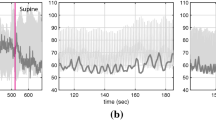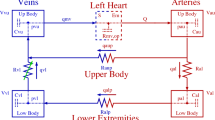Abstract
This paper introduces a model designed to study the cardiovascular-respiratory system and its control features. It has been previously applied to study several physiological situations and in this paper it will be applied to the simulation of the phenomenon of orthostatic stress. Orthostatic stress refers to stress placed on the cardiovascular system when the body is in the upright position as compared to the supine position. The model consists of cardiovascular and respiratory components and includes cardiovascular autoregulation, ventilation control, and the baroreflex loop. Instead of an explicit formula for calculating the control response from the pressures and blood gases, we use an optimal control. Steady state and dynamic model simulation is compared with experimental data we have collected using head up tilt (HUT) experiments. The simulations fit the measured data well and represent reasonable physiological values. This work also examines an important issue related to orthostatic stress experiments. The head up tilt experiment (where gravity creates extra pressure stress on the lower body) is to be distinguished from the lower body negative pressure (LBNP) experiment where the lower body is subject to reduced exterior air pressure. Both tests create blood volume shifts to the lower body but the two physiological conditions are not entirely equivalent. We discuss some of these issues and examine several aspects of implementation of orthostatically induced pressures.
Similar content being viewed by others
References
Berne R, and Levy M. Cardiovascular Physiology, 7th Ed., St. Louis, MO: Mosby, 1997.
Boyers DG, Cuthbertson JG, and Luetscher JA. Simulation of the human cardiovascular system: A model with normal response to change in posture, blood loss, transfusion, and autonomic blockade. Simulation 18: 197-205, 1972.
Burton RR. Mathematical models for predicting g-duration tolerances. Aviat Space Environ Med 71: 981-990, 2000.
Croston RJ, and Fitzjerrell DG. Cardiovascular model for the simulation of exercise, lower body negative pressure, and tilt table experiments. In Proceedings of the 5th Annual Pittsburgh Conference on Modeling Simulation, 24-26 April 1974, Pittsburgh, PA, pp 471-476, 1974.
Hao WY, Bai JY, Wu X, and Zhang LF. Simulation study of the effects of hypovolaemia on cardiovascular response to orthostatic stress. Med Biol Eng Comput 41(1): 44-51, 2003.
Heldt T, Shim EB, Kamm RO, and Mark RG. Computational modeling of cardiovascular response to orthostatic stress. J Appl Physiol 92: 1239-1254, 2002.
Kappel F, and Peer RO. A mathematical model for fundamental regulation processes in the cardiovascular system. J Math Biol 31(6): 611-631, 1993.
Karam EH, Srinivasan RS, Charles JB, and Fortney SM. The effect of blood volume loss on cardiovascular response to lower body negative pressure using a mathematical model. J Gravit Physiol 1(1): P96-P97, 1994.
Leonard JJ, Leach CS, and Rummel JA. Computer simulations of postural change, water immersion, and bedrest: An integrative approach for understanding the spaceflight response. Physiologist 22: S31-S32, 1979.
Melchior FM, Srinivasan RS, Thullier PH, and Clere JM. Simulation of cardiovascular response to lower body negative pressure from 0 mmHg to 40 mmHg. J Appl Physiol 77: 630-640, 1994.
Patton HD, Fuchs AF, Hille B, Scher AM, and Steiner R (Eds.). Textbook of Physiology Philadelphia: W.B. Saunders, 1989.
Peterson K, Ozawa ET, Pantalos GM, and Sharp MK. Numerical simulation of the influence of gravity and posture on cardiac performance. Ann Biomed Eng 30(2): 247-259, 2002.
Rickards CA, and Newman DG. The effect of low-level normobaric hypoxia on orthostatic responses. Aviat Space Environ Med 73(5): 460-465, 2002.
Rowell LB. Human Cardiovascular Control, London: Oxford University Press, 1993.
Russell RD. Mathematics of Finite-Dimensional Control Systems: Theory and Design, Marcel Dekker, 1979.
Sud VK, Srinivasan R, Charles JB, and Bungo MW. Effects of lower body negative pressure on blood flow with applications to the human cardiovascular system. Med Biol Eng Comput 31: 569-575, 1993.
Timischl S. A Global Model of the Cardiovascular and Respiratory System, PhD Thesis, Karl Franzens Universität Graz, Austria, 1998.
Walsh C, Cirovic S, Frase WD, and Samin A. A model of short term cardiovascular regulation. In Bioengineering Conference, Vol 50, pp 901-902, ASME, 2001.
White RJ, Fitzjerrell DG, and Croston RC. Fundamentals of Lumpede Compartmental Modelling of the Cardiovascular System, Vol. 5.1, Basel, Switzerland: Karger, pp. 162-184, 1983.
Author information
Authors and Affiliations
Corresponding author
Rights and permissions
About this article
Cite this article
Fink, M., Batzel, J.J. & Kappel, F. An Optimal Control Approach to Modeling the Cardiovascular-Respiratory System: An Application to Orthostatic Stress. Cardiovascular Engineering 4, 27–38 (2004). https://doi.org/10.1023/B:CARE.0000025120.30148.7a
Issue Date:
DOI: https://doi.org/10.1023/B:CARE.0000025120.30148.7a




